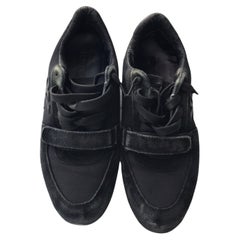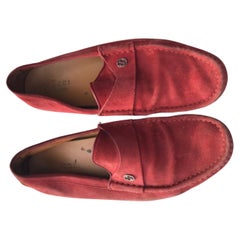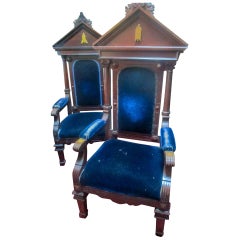Suede Political and Patriotic Memorabilia
2
to
2
2
2
2
855
144
70
35
31
Material: Suede
louis vuitton sneakers
Located in Нұр-Сұлтан, KZ
Louis Vuitton sneakers are made of suede, black, were previously used, size 40 European in one of the photos it is visible on the tongue, in the photo ...
Category
21st Century and Contemporary Suede Political and Patriotic Memorabilia
Materials
Suede
Men's Gucci loafers, size 8.5
Located in Нұр-Сұлтан, KZ
Men's Gucci loafers, size 8.5, previously used, condition in photo
Category
21st Century and Contemporary Suede Political and Patriotic Memorabilia
Materials
Suede
Related Items
British Soldier's Woolwork or Woolie, 19h Century
Located in Pasadena, CA
This is an exceptional example of a 19th century British soldier's "Woolie" or woolwork that is signed "G.W. Whitby/India. The woolwork depicts the ...
Category
Early 19th Century English British Colonial Antique Suede Political and Patriotic Memorabilia
Materials
Wool, Glass, Wood
Pair 19th Century Victorian Eastlake Free Mason Throne Chairs w/ Symbolism
Located in Savannah, GA
Victorian Eastlake large upholstered solid oak throne chairs from Masonic Lodge with lots of detailed carving. The pair consists of one with the plumb bob sy...
Category
1880s American Eastlake Antique Suede Political and Patriotic Memorabilia
Materials
Velvet, Oak
Barons Delaware Boston Joined Chest of Drawers, US American Colonial
Located in Amsterdam, NL
A joined enclosed American walnut, white oak, pine, beech, maple, krappa (crabwood), and letterwood Boston chest of drawers with lidded top
Ipswich/Bosto...
Category
Mid-17th Century American American Colonial Antique Suede Political and Patriotic Memorabilia
Materials
Wood
H 48.82 in W 48.04 in D 27.96 in
Japanese Screen Depicting USA Commodore Perry’s Flagship the USS Mississipi
Located in Amsterdam, NL
A rare and fine Japanese six-fold gold-leaf screen with the depiction of Commodore Matthew Perry’s flagship the USS Mississippi
Early Bakumatsu period (1853-1867)
Measures: H. 61 x W. 183 cm
Provenance:
Private collection, USA
On 8 July 1853 Commodore Matthew Perry with his paddle-wheel warships USS Mississippi and Susquehanna, and two sloops, with a total of 65 guns and little less than 1000 man, for the first time arrived in the harbour of Shimoda, in the bay of Edo, in his own words, “to open doors of commerce, and spread civilization to a backward people, and also to spread the Gospel of God to the heathen.” In Japanese parlance, the American ships quickly became known as “black ships,” depicted as demonic monsters. For the Japanese, these huge coal-burning ships...
Category
Late 19th Century Japanese Antique Suede Political and Patriotic Memorabilia
Materials
Paint, Paper
Free Shipping
H 23.63 in W 72.05 in D 1.58 in
1912 Roosevelt Turkey Red Bandana, ca 1912
Located in York County, PA
Turkey red bandanna, made for the 1912 presidential campaign of teddy Roosevelt, when he ran on the independent, progressive party (bull moose) ticket
Printed cotton kerchief, made for the 1912 presidential campaign of Theodore Roosevelt when he ran on the Progressive Party ticket (a.k.a., the Bull Moose campaign). This graphic textile, in a classic, western style, typical of the iconic red bandanna, is indicative of both the Republican Party in the late 19th century, and T.R.’s love of the American West.
In this example, a geometric design with diamonds, surrounded by multiple, linear borders, is accompanied by the following text along the top and bottom that reads: “The Roosevelt Bandanna” and “Progressive Party,” respectively. A maker’s mark in the lower right corner reads “Cochranes Mfg. Co.” Cochrane’s was known for their long-lasting, red dye process, called “Cochrane’s Turkey Red.”. It was really a process, as opposed to a dye itself, to which the name applied. The dye was actually a derived from a synthetic colorant called “alizarin,” imported by Alexander Cochrane’s family, who emigrated to the United States from 1847, and owned a chemical company in Massachusetts that produced the dye. The fabrics were produced by the family of John Cochrane, who emigrated from Renfrewshire, Scotland in 1844. Both families, who resided in Malden, Massachusetts initially, traced their ancestry to Barrhead, Scotland, in the heart of the textile-producing region, near Glasgow and Paisley. It was in Glascow that Turkey Red printed bandannas are said to have originated, in the shop of Henry Monteith & Company, in 1802.*
TR's decision to enter the 1912 election was not exactly popular among many of his friends and former supporters. His participation manifested into a unique political incident, in which the independent, Roosevelt, beat out a major party ticket, garnering 27.4% of the vote. At the same time, however, he lost the White House, not only for himself, but for his former Republican friends as well, by dividing support between his own candidacy and that of incumbent President William Howard Taft...
Category
1910s American Vintage Suede Political and Patriotic Memorabilia
Materials
Cotton
Antique American Flag w/ Hand-Written Inscriptions Mourning the Death of FDR
Located in York County, PA
48 STARS ON ANTIQUE AMERICAN FLAG WITH HAND-WRITTEN INSCRIPTIONS AND AN EMBROIDERED DATE OF APRIL 12TH, 1945, MOURNING THE DEATH OF PRESIDENT FRANKLIN DELANO ROOSEVELT:
American national parade flag with 48 stars, printed on cotton, embellished with hand-written inscriptions and an embroidered date to commemorate the death of FDR on April 12th, 1945.
“On this day in 1945, President Franklin D. Roosevelt died of a massive cerebral hemorrhage at his Warm Springs, Georgia, retreat at the age of 63. Roosevelt’s death in the final months of World War II was met with shock and grief throughout the Western world. Many Americans had no inkling of his decline in health. [He] had been president for more than 12 years, longer than any other person. He led the country through some of its greatest domestic and foreign crises to the impending defeat of Nazi Germany and within sight of Japan’s surrender...
Category
1940s American Vintage Suede Political and Patriotic Memorabilia
Materials
Cotton
H 19.5 in W 25.5 in D 2.5 in
Large 48 Star Embroidered Flag Pillow
Located in Los Angeles, CA
This monumental 48 star flag pillow is in great in great condition and has a red cotton linen pillow. The big pillow id down and feather fill.
Category
Mid-20th Century American Country Suede Political and Patriotic Memorabilia
Materials
Cotton
Antique 46 Star WMH Horstmann Company United States of America Flag 83"
By Horstmann
Located in Dayton, OH
Antique forty six star large wool American flag by Horstmann Company, circa 1908-1912.
Horstmann firm was founded by William H. Horstmann (1785-1850), who had immigrated to Philadelphia from Germany. Horstmann bought out a local swordmaker in 1828 and thereafter entered the military goods field. The firm benefitted from the Civil War, becoming the largest military goods supplier in the nation by 1864.
WILLIAM H. HORSTMANN & SONS, Manufacturers of Dress Trimmings and Military Goods. 5th & Cherry Streets, Philadelphia, PA.
This house was founded, in 1815, by William H. Horstmann, a native of Cassel, in Germany. He had learned the trade of silk-weaving in France, and, emigrating to the United States in the above-mentioned year, established himself in Philadelphia as a manufacturer of fringe, laces and trimmings of various kinds. He married the daughter of Frederick Hoeckly, a German settler in Philadelphia, and also a manufacturer of fringe, coach-lace and tassels. He devised several improvements in this trade, especially by introducing varieties in the styles and patterns of this class of goods, there being at that time only two patterns used in the trade, which were known as the Jefferson pattern and the Monroe pattern.
In 1824, he introduced into this country from Germany the use of plaiting or braiding machines, and about the same time he was the first to introduce into this country the use of the Jacquard loom, for weaving patterns in textile fabrics. His location was in the first instance at No. 50 North Third street, but within a short time he removed to a store next to the Harp and Crown tavern, afterwards known as the City hotel, and continued his business within a short distance of this point for many years.
In 1828, he commenced the manufacture of military trimmings as a special department, and this branch has grown to most important proportions, Horstmann's military goods being in demand throughout time country. The firm have also executed large Government contracts in this line for the War and Navy Departments. In 1831, he established a branch house in New York city, and about the same time erected a factory at the corner of Germantown road and Columbia avenue. The factory was continued here until time erection of the extensive building at Fifth and Cherry streets, where the works, salesrooms and offices of time firm now are. This massive structure is six stories high, and extends 140 feet on Fifth street and 200 on Cherry street, and reaches back to Race street. The separate departments into which the business is divided are thirty in number. More than 1000 distinct looms and machines are in use in the building, many of them very costly and some invented and used exclusively by this firm, the motive power being supplied by a steam engine of fifty horse power. The area covered by the works is about 11,000 square feet. Time number of hands employed is very large, about 500. When the erection of a vast factory at this point was first proposed, a strong opposition was made by time holders of the neighboring property. The ancient German Lutheran Church and burying ground, since removed, stood opposite the site, and a bill was introduced into the Legislature to forbid the use of a steam engine within 100 yards of any place of worship. The interests which such a bill would have affected injuriously, especially those of several newspapers, roused a strong opposition to it, and it failed to become a law. In 1845, William H. Horstmann, the founder of the house, retired from the business, and his two sons, William and Sigmund, assumed the management and it was under their direction that the new building, above described, was erected.
The goods produced by this house are of almost endless extent and variety. They include goods woven from all the various textile fibres—cotton, wool, silk, etc.—in every style, color and pattern, and are used for an infinite number of purposes. Narrow woven goods are time staple production, made up into material for dresses for both sexes, for use in daily life, and for regalia for ""societies;"" for the costumes of the stage, the upholstering of houses and of carriages, the uniforms of soldiers, together with equipments for the same, and for funeral purposes. The raw material used in the manufacture is to a great extent very costly, and their store rooms often hold as much as $200,000 worth of goods in an unworked state. There are two rooms devoted to power looms in the factory, one for coach lace and one for other styles of weaving, in which about 250 of these machines are constantly running. The braiding machines in the coach lace room are very noteworthy. The cord to be covered with braid is drawn through an opening in time middle of a flat, circular, metallic plate, about 15 inches across. Up to a point on this cord, about a foot above the plate, the threads of the braiding material converge, like the ribs of a tent-roof, and there weave in and out and out and in, as the coating of braid grows, and time covered cord rises and is wound away above. The weaving is accomplished by the motion of the spools below that carry the different threads of the braid. These spools stand in uprights, which are carried round and amongst each other in curved slots in the above-mentioned broad metallic plate. All but two of these spools run in and out among each other, with a swift, easy and intricate motion, mind so rapid that time eye can hardly follow it, while one or two special spools run steadily round and round among time twisting spools with the most extreme swiftness. Many other machines, displaying equally ingenious mechanism, are used in the factory. The various details of equipment manufactured and supplied by this house are also important, both for their number and the superior quality of the manufacture.
The one article of swords may be taken as an instance. This trade grew naturally and immediately out of the established army and navy goods department of the works, it being necessary that the sword itself should be furnished together with the sword-belt and other trappings all complete. Every part of the sword and trappings, with the exception of the blade, is made on the premises. The blades are almost all imported from the ancient German sword-blade emporium of Solingen, where, it is said, swords have been made ever since the year 1147, when Count Adolphus of Berg brought home from the East and established there the business of forging Damascus blades. There is in this department a stock of some thousands of blades, of many different patterns and sizes, ready to be set and finished. Any style or sword can be had from this warehouse, from the plainest kind up to a presentation sword...
Category
1910s American Classical Vintage Suede Political and Patriotic Memorabilia
Materials
Wool
Vintage French Military Academy Officers Hat, Mid Century
Located in South Salem, NY
A rare French Military Academy Officer's hat or cap from the 1970s. These special and unique hats are part of the uniform of students studying to become officers in the French Milita...
Category
1970s French Vintage Suede Political and Patriotic Memorabilia
Materials
Felt
Large Vintage Valley Forge American Flag with 48 Stars c.1940-1950-FREE SHIPPING
Located in San Francisco, CA
ABOUT
A large Valley Forge American flag made with 48 hand sewn stars and stripes. It is in good condition and has brass grommets to hang.
CREATOR Valley Forge.
DATE OF MAN...
Category
Early 20th Century Industrial Suede Political and Patriotic Memorabilia
Materials
Brass
H 117 in W 57.5 in D 0.125 in
Pair of Cast Iron George Washington Figural Andirons
Located in New York, NY
Pair of cast iron George Washington Andirons:
Measures: 9" x 20" x 16"
Weighs: 30 LBS.
Category
Early 20th Century American American Classical Suede Political and Patriotic Memorabilia
Materials
Iron
Blue Ceramic Cross with Circular Embellishments, Unique Religious Collectible
Located in Chicago, IL
A midcentury ceramic cross made by Flemish artisan in deep and bright Klein blue. Each tip of the cross and its center are adorned with circular embellishments in hollow relief, addi...
Category
1950s European Arts and Crafts Vintage Suede Political and Patriotic Memorabilia
Materials
Ceramic
H 5.5 in W 4.63 in D 0.5 in
Recently Viewed
View AllMore Ways To Browse
Burgee Diamond
Antique Diamond American Flag
Naval Jack
Signer Of Declaration
John Horse Seminole
Toy Singer Sewing Machine
Uncle Sam Whirligig
Carved Wood Bears
E H Rigg
Tar Bucket
Vintage 50 Star American Flag
Patriotic Vintage Americana
Fante Applique
Initial H Medallion
Suffragette Memorabilia
James Hayes
Very Whimsical Draped
Vintage Asafo Flags



